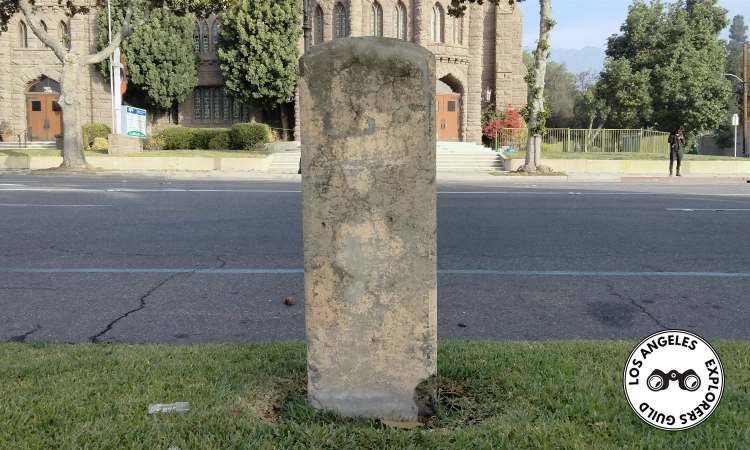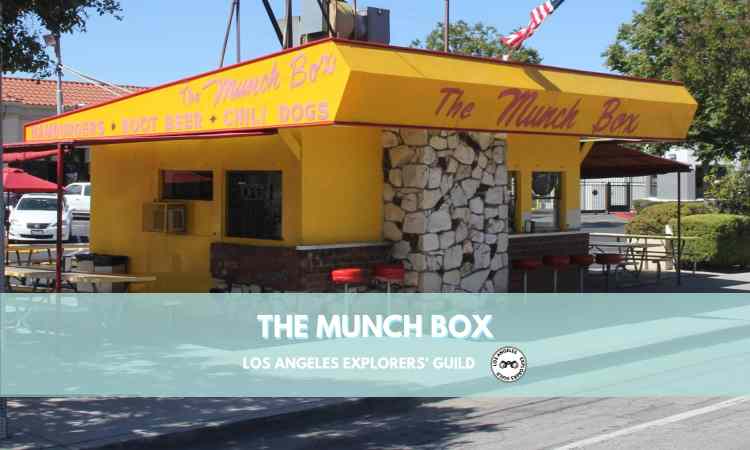On Colorado Boulevard in Pasadena you can find a relic of the first road system in Los Angeles.
A Memorial to the first Freeway System of L.A.
The Foothill Bancroft Marker is an unassuming concrete block, almost invisible in front of a McDonald’s It’s something of an oddity, a concrete monolith five feet tall, one foot wide, six inches thick, reinforced with barbed wire and buried 18 inches in the ground.
It resembles a tombstone, which is sort of fitting since it’s all that remains of the very first freeway system of Los Angeles.

This is one of the mile markers established by Alfred Bancroft’s Ten-Block System established in 1902. Such a marker was placed along each mile of Foothill Boulevard, measured from the old Red Sandstone Courthouse in downtown Los Angeles (where the Stephen M. White statue once stood) and continuing to the end of the road in the San Gabriel foothills.
This particular marker was (as you may guess from the engraved number at the top) placed at Mile 11. It also established blocks 220 and 222, while the F.B. at the bottom is stone marker shorthand for Foothill Boulevard.
The Legacy of Albert Little Bancroft
In 1890, after reading an an editorial in the Contra Costa Semi-Weekly Gazette about the challenges of introducing a numbering system for homes in a rural area, a man named Albert Little Bancroft conceived of an easy to implement rural road numbering system. His idea called for a “Ten Block System for Numbering Houses,” inspired during his visit to Europe in 1869.
The concept behind Bancroft’s Ten-Block Numbering System is simple — addresses would be assigned to parcels of land instead of existing structures (which was the practice in most cities at the time). Roads would be measured from a specific point in front of the county courthouse and designed to be as straight as possible for as long as possible. The roads would be given obvious and pleasant names that were relevant to the area’s topography, history, and even botany (like Orange Grove Avenue, for example).
Bancroft’s plan is very much in the style of the Mile 0 (or Kilometer 0) concept the Romans used when building cities (the Kilometre Zero marker in Paris is right in front of Notre Dame Cathedral).
The Latest Exploration …
Alta Cienega Motel: The Other Morrison Hotel
It’s been called the most disgusting hotel in Los Angeles. It’s also been called a must-see destination for any serious fan of The Doors. No, it’s not Morrison Hotel. It’s Jim Morrison’s final home in West Hollywood.
Keep readingThe Ten-Block System
Bancroft’s system divided every mile of every road into blocks of 528 feet (one-tenth of mile). Each block would have two numbers assigned to it — the right side would be an even number and the left side would be an odd number. A little multiplication allows for 20 numbers along every mile of road.
The first house built on a lot would be assigned the number of that lot. Using the Foothill Bancroft Marker as an example, the first house in the 11th block would have an address of 220. Any subsequent houses built on that lot would still have the number 220 but would be amended with a letter — 220a, 220b, 220c.
After enthusiastically adopting the Bancroft System in 1892, the governing forces of Contra Costa County completely abandoned the whole “Contra Costa Plan” (as it was first called) only four years later. This was primarily for economic reasons — the system needed a lot of signs and no one was really willing to pay for them.
Albert Bancroft Comes to Los Angeles
So Albert Bancroft, likely on the verge of bankruptcy after self-funding much of his “Contra Costa Plan,” started taking business trips to to Los Angeles. Upon arriving in the city, he almost immediately began pitching his ten-block plan to anyone who would listen. While there was some interest in the system (testament to an article Bancroft wrote that the Los Angeles Times printed in 1897) Bancroft was about five years too early.
It wasn’t until 1902 that the city, as part of a “Good Roads” initiative, put out a call for citizens to help develop a road-numbering system for the outlying areas of Los Angeles County. By this time, Bancroft seems to have relocated to Los Angeles and gladly stepped into the fray, introducing an improved version of the Ten-Block Numbering System.
His upgraded plan included, in addition to aesthetic features like tree-line boulevards, a series of concrete milestones that displayed the distance from the courthouse, the name of the road, and the block numbers.
His plan was again received with enthusiasm, and he was appointed to the newly formed Highway Commission of Los Angeles County. This commission worked for six years and marked six major country roads — Foothill Boulevard, San Diego Road, San Bernardino Road, San Fernando Road, Whittier Avenue, and El Camino Real.
Then, in 1908, the whole project sort of fizzled out when the new Los Angeles County Highway Commission was established and the previous, similarly named entity was dissolved.
As for Bancroft, he left Los Angeles in 1905. He bounced around the country for a few years, eventually returning to California in 1914, the year he died.

Foothill Boulevard Milestone — Mile Marker 11
Because of its status as the “only and remaining pre-war road marker in Pasadena,” this monument was placed on the National Register of Historic Places as the Foothill Boulevard Milestone (Mile 11) in 1996.
However, where the Foothill Bancroft Marker sits today is not its original location. In 1994, the marker was moved 25 feet to the east to accommodate the driveway for the McDonald’s that now sits behind it.
Foothill Bancroft Marker
- 1320 E Colorado Blvd, Pasadena (at Holliston)
- GPS Coordinates: 34.14587, -118.12318 [ Google Maps ]
- what3words: ///solved.drum.brick
Our Most Recent Explorations







